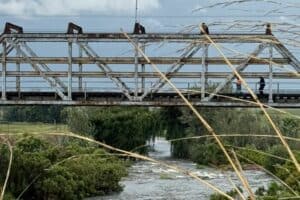The DBE warned the number of pupils who died or are missing from the deluge could be much higher.

At least 64 pupils have died as a result of the devastation caused by the catastrophic floods in KwaZulu-Natal.
It was initially reported that 57 children were part of the 435 people in KZN who died due to the natural disaster.
But on Thursday Cabinet ministers from the Social Protection, Community and Human Development Cluster (social cluster) confirmed more pupils had died.
The social cluster includes the ministers of health, basic education and social development.
Missing pupils
Speaking during a media briefing by the social cluster, Health Minister Dr Joe Phaahla said five pupils were still missing since the deluge struck KZN two weeks ago.
He said the basic education sector was severely affected by the floods.
“More than 630 schools were affected, 101 inaccessible and 124 have suffered extensive damage. Schooling is proceeding elsewhere in the province, but in the affected areas attendance is uneven,” Phaahla said.
“Attendance is uneven but we remain hopeful that with all the support there will be a gradual increase in learners and teachers returning to school.”
ALSO READ: KZN floods: Damage reports reveal massive flood cost in KwaDukuza
The spokesperson for the Department of Basic Education (DBE), Elijah Mhlanga, warned that the number of pupils who died or were still missing from the downpours could be higher.
“As the recovery effort is continuing, we are expecting that the number would be much higher,” he said.
Mhlanga said not all of the 630 schools in KZN were damaged by floods.
“Among the 630 schools, some had been cut off as a result of the floods but the schools themselves were still in a good condition.”
Mhlanga said the department visited all the affected schools and categorised them according to the extent of damaged caused.
“There are 41 schools which are going to be fixed by the schools themselves through the norms and standards allocation. And there are 263 schools that are going to be fixed by the district offices through the equitable share.
“There are 300 schools which are going to be fixed using implementing agents, which means these are schools that have suffered extensive damage which requires professionals.”
R440 million
Mhlanga said approximately R440 million would be required to repair damaged school infrastructure.
“The R440 million which we have since been reporting on is based on the assessment which was done after visiting all the schools and receiving reports from district officials and officials going out to assess the damage,” he said.
The number of schools that were inaccessible due to damaged roads and bridges decreased to 52, Mhlanga said.
“By this afternoon [Thursday] the number would have come down even further because the Department of Transport and other agents of government are working with us to prioritise those areas so that learners are able to go back to schools together with their teachers.”
Mhlanga said the school attendance rate at public schools was above 90%.
“The province of KZN has put together a comprehensive recovery plan which is currently being applied in all the affected areas. And we are confident that they will be able to recover.”
He added that 633 pupils were being accommodated in community centres after being displaced by floods.
“We’ve since provided them with clothing, books and other basic necessities that they need. We also have about 455 learners that are being given books.”
Government said it would also monitor how youth with disabilities would return to school as well as the impact of the floods on their education.
NOW READ: Damaged school infrastructure: What now for KZN pupils?






